Suite¶
Models¶
MyoSuite consists of five models: myoFinger, myoElbow, myoHand, myoArm and myoLeg. Using these models, we design a rich collection of tasks ranging across simple reaching movements, contact-rich movements involving object-manipulation such as pen-twirling and baoding balls, as well as locomotion behaviors.
myoFinger¶
Simplified and intuitive model (based on Xu et al. (2012)) of a 4 Degree of Freedom (DoF) finger which is actuated through a series of 5 simplified antagonistic muscle-tendon units. We also provide its robotic counterpart with simple torque actuators to facilitate the comparative investigation.
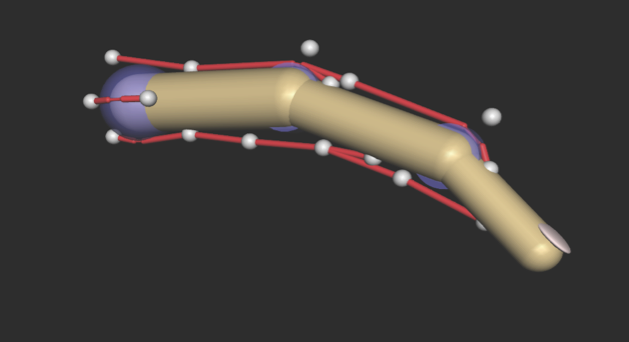
myoElbow¶
A model of 2 DoF human elbow joint – based on OpenSim’s default testing arm model (Delp et al. (2007); Seth et al. (2018)) – and actuated using multiple agonist/antagonist pairs (3 flexors and 3 extensors).
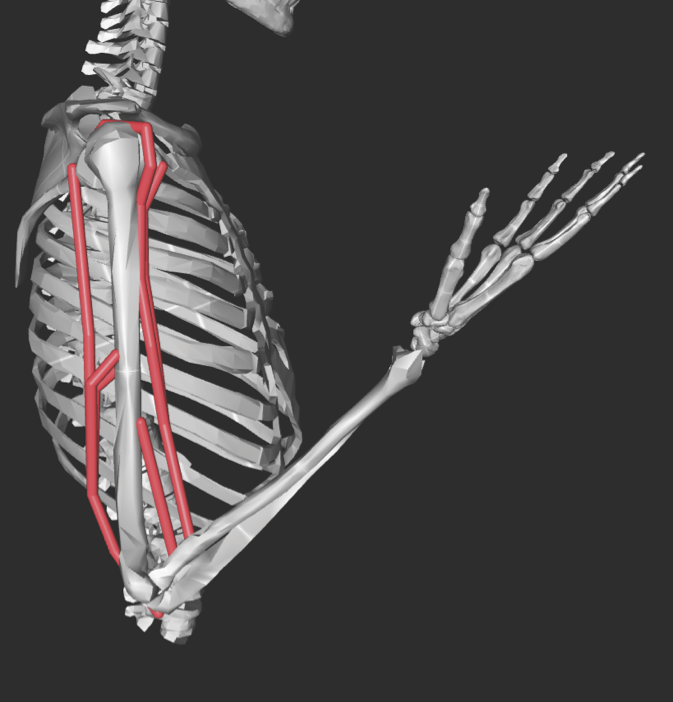
Acronym |
Muscle |
|---|---|
TRIlong |
Triceps long |
TRIlat |
Triceps lateral |
TRImed |
Triceps medial |
BIClong |
Biceps long |
BICshort |
Biceps short |
BRA |
Brachioradialis |
myoHand¶
The dexterous human hand requires coordination of multiple highly redundant muscles, which have complementary and antagonistic effects on various joints. This musculoskeletal model is comprised of 29 bones, 23 joints, and 39 muscles-tendon units.

Acronym |
Muscle |
|---|---|
ECRL |
Extensor Carpis Radialis Longus |
ECRB |
Extensor Carpis Radialis Brevis |
ECU |
Extensor Carpi Ulnaris |
FCR |
Flexor Carpi Radialis |
FCU |
Flexor Carpi Ulnaris |
PL |
Palmaris longus |
PT |
Pronator teres |
PQ |
Pronator |
EIP |
Extensor Indicis Proprius |
EPL |
Extensor Pollicis Longus |
EPB |
Extensor Pollicis Brevis |
FPL |
Flexor Pollicis Longus |
APL |
Abductor Pollicis Longus |
OP |
Opponens Pollicis |
FDS |
Flexor Digitorum Superficialis (2- index, 3- middle, 4- ring, 5- little) |
FDP |
Flexor Digitorum Profundus (2- index, 3- middle, 4- ring, 5- little) |
EDC |
Extensor Digitorum Communis (2- index, 3- middle, 4- ring, 5- little) |
EDM |
Extensor Digiti Minimi |
RI |
Radial Interosseous (2- index, 3- middle, 4- ring, 5- little) |
LU-RB |
Lumbrical (2- index, 3- middle, 4- ring, 5- little) |
UI-UB |
Palmar or Ulnar Interosseous (2- index, 3- middle, 4- ring, 5- little) |
myoLeg¶
The 3D dexterous human leg requires coordination of multiple highly redundant muscles, which have complementary and antagonistic effects on various joints.
This musculoskeletal model is comprised of 10 joints, 20 DoFs, and 80 muscles-tendon units. This musculoskeletal model takes Rajagopal’s full body gait model [https://github.com/opensim-org/opensim-models/tree/master/Models/RajagopalModel] as close reference.
Joints and muscle details can be found in Rajagopal’s paper [https://ieeexplore.ieee.org/document/7505900]
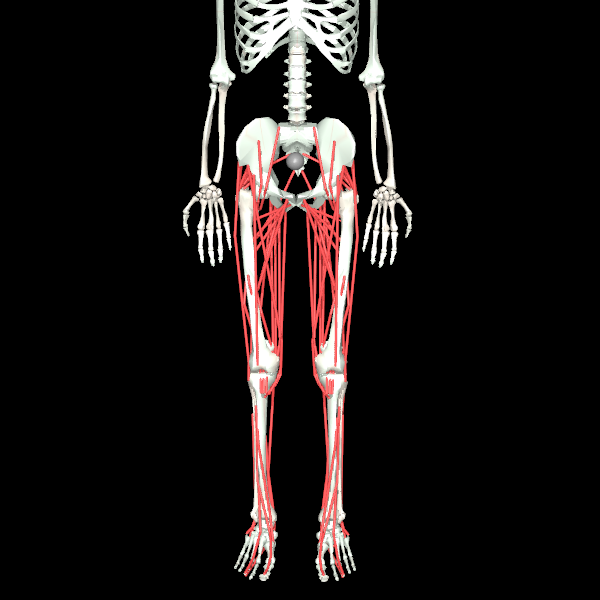
myoArm¶
The 3D dexterous human arm reaching and manipulation.
This musculoskeletal model is comprised of 27 Degree of Freedom, and 63 muscles-tendon units.
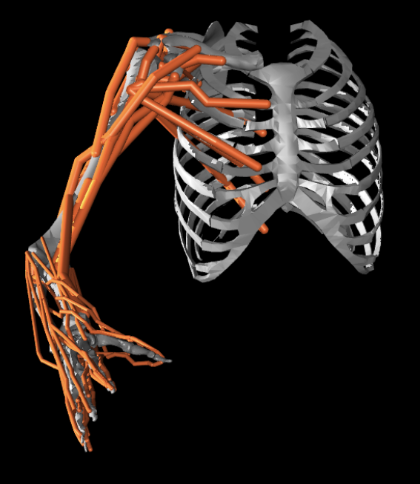
Tasks¶
Finger Joint Pose¶
- Objective:
Strike a joint pose
- Variants:
Easy: Move to a fixed specified joint pose
myoFingerPoseFixed-v0Hard: Move to randomly selected joint poses
myoFingerPoseRandom-v0More: Random resets, no resets, dense rewards, sparse rewards
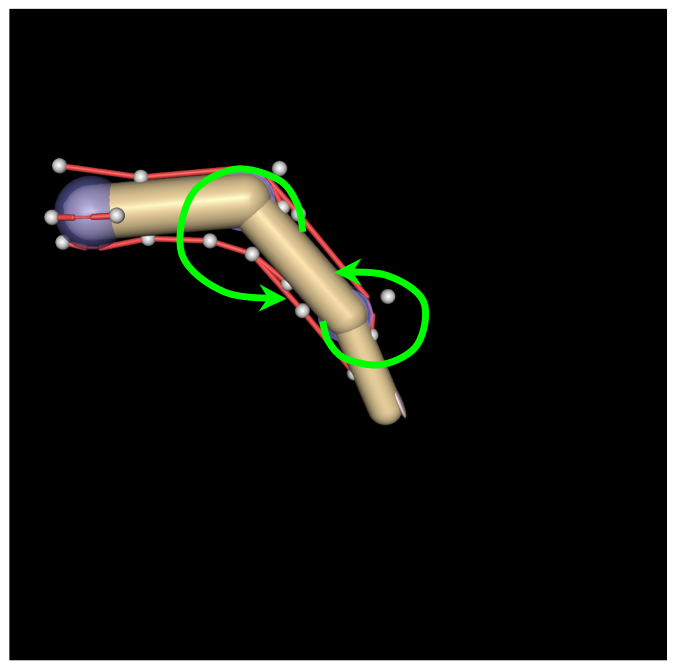
Finger Tip Reach¶
- Objective:
Reach using finger tips
- Variants:
Easy: Reach to a fixed location
myoFingerReachFixed-v0Hard: Reach to random locations
myoFingerReachRandom-v0More: Random resets, no resets, dense rewards, sparse rewards
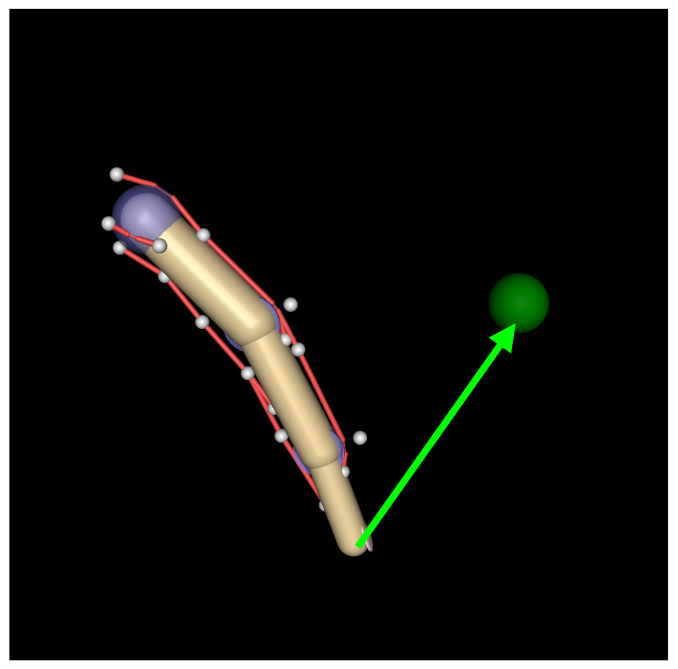
Elbow Joint Pose¶
myoElbow model with 6 muscles (3 flexors and 3 extensors) was simplified to have only elbow rotations. Although it is not a physiologically accurate model it can be a very simple model for troubleshooting initial control schemes.
- Objective:
Move elbow to a specified pose.
- Variants:
Easy: Move to random joint poses using 1 muscle
ElbowPose1D1MRandom-v0Hard: Move to random joint poses using 6 muscles
myoElbowPose1D6MRandom-v0More: Random resets, no resets, dense rewards, sparse rewards
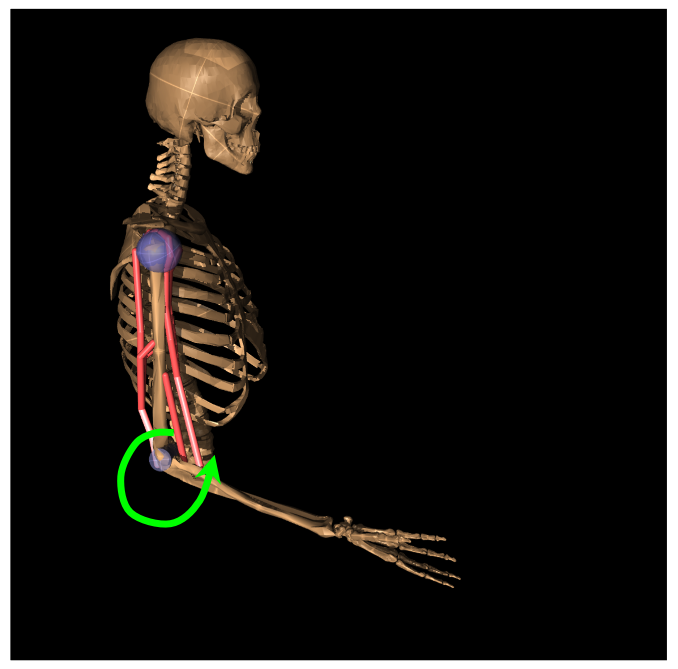
Hand Joints Pose¶
Drive the myoHand model to achieve a joint poses. In addition to making co-ordinated movements, avoiding self collisions poses additional challenges in solving this task.
- Objective:
Strike a hand pose
- Variants:
Easy: Move to a fixed joint pose
myoHandPoseFixed-v0Hard: Move to a randomly selected joint pose
myoHandPoseRandom-v0More: Random resets, no resets, dense rewards, sparse rewards
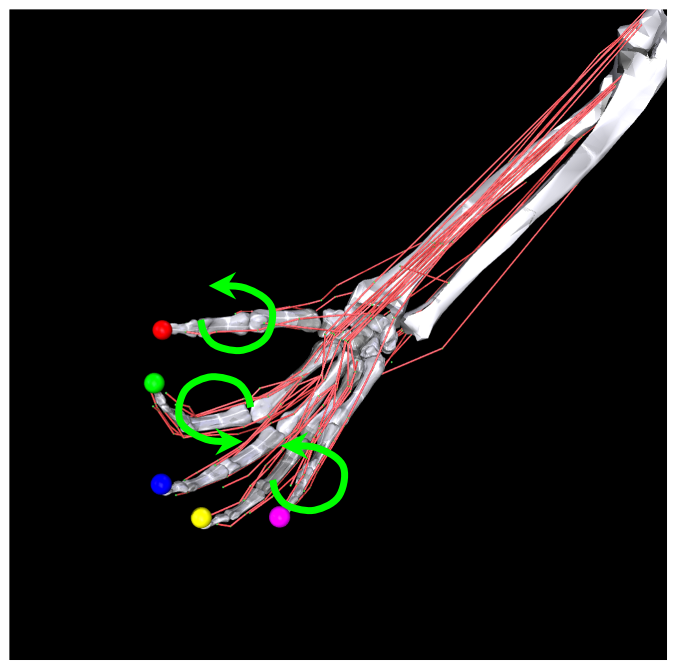
Hand Tips Reach¶
Make reaching movements using the myoHand model to have finger tips achieve a specific spatial position. In addition to making co-ordinated movements, avoiding self collisions poses additional challenges in solving this task.
- Objective:
Reach using finger tips
- Variants:
Easy: Reach fixed positions using finger tips
myoHandReachFixed-v0Hard: Reach random positions using finger tips
myoHandReachRandom-v0More: Random resets, no resets, dense rewards, sparse rewards
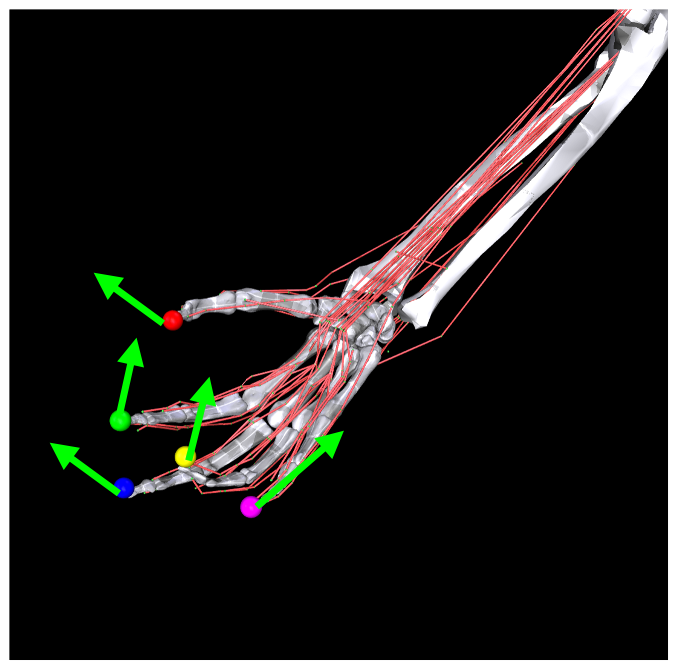
Hand Key Turn¶
Use the the myoHand model to rotate a key. The complexity of this task is due to the use of only index and thumb fingers to solve the task with intermittent contact with the key.
- Objective:
Coordinate finger movements to rotate a key
- Variants:
Easy: Achieve half rotation of the key
myoHandKeyTurnFixed-v0Hard: Achieve full rotation + random initial configuration
myoHandKeyTurnRandom-v0More: Random resets, no resets, dense rewards, sparse rewards
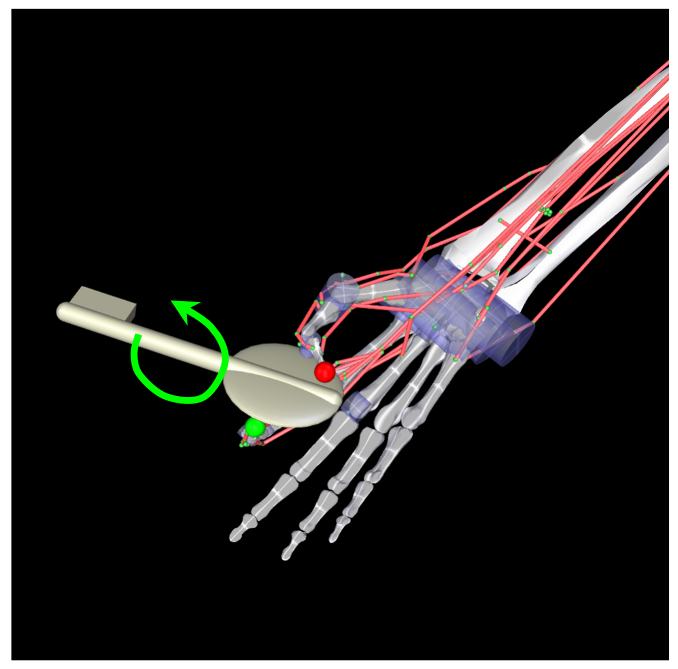
Hand Object Hold¶
A myoHand model moves an object in the hand to a given orientation without dropping it. The complexity of this task is due to the intermittent contacts between the object and multiple fingers needing co-ordination to stabilize the object.
- Objective:
Reposition an object to reach a given target without dropping it.
- Variants:
Easy: Reposition to a fixed position
myoHandObjHoldFixed-v0Hard: Reposition a random object to random positions
myoHandObjHoldRandom-v0More: sparse rewards, dense rewards, random resets, reset free
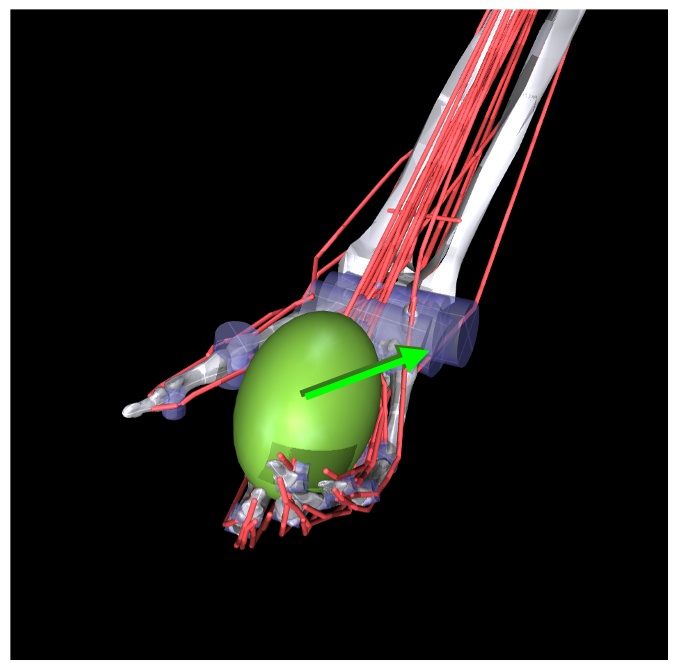
Hand Pen Twirl¶
A myoHand model rotates a pen in the hand to a given orientation without dropping it. The complexity of this task is due to the intermittent contacts between the object and multiple fingers while trying to stabilize the object.
- Objective:
Rotate the object to reach a given orientation (indicated by the green object in the scene) without dropping it.
- Variants:
Easy: Rotate to fixed orientation
myoHandPenTwirlFixed-v0Hard: Rotate of random orientation
myoHandPenTwirlRandom-v0More: sparse rewards, dense rewards, random resets, reset free
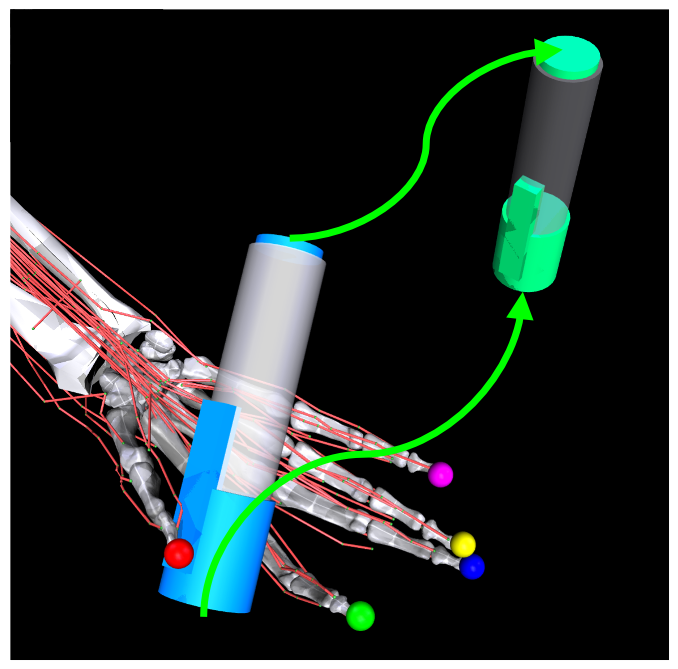
Hand Multiobject Reorientation¶
A myoHand model reorients a set of parameterized geometries to a given target orientation without dropping it. As with before, the complexity of this task is due to the intermittent contacts between the object and multiple fingers while trying to stabilize the object, as well as the multiobject nature of the task.
- Objective:
Rotate one randomly chosen object in the set to reach a given orientation without dropping it.
- Variants:
Easiest: Eight-object reorientation
myoHandReorient8-v0Easy: 100-object reorientation
myoHandReorient100-v0Hard: 1000-object orientation (in-domain parameterized geoms)
myoHandReorientID-v0Hardest: 1000-object orientation (out-of-domain parameterized geoms)
myoHandReorientOOD-v0
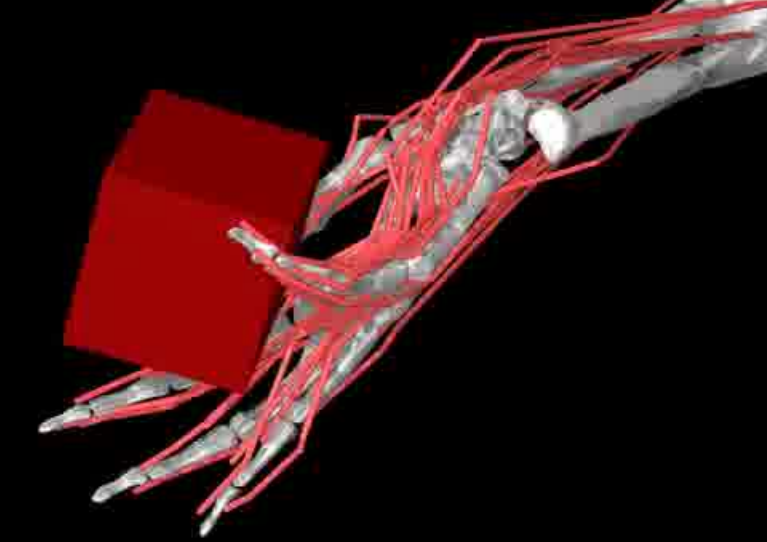
Hand Die Rotation (MyoChallenge 2022)¶
A myoHand model involved for reconfiguring a die to match desired goal orientations. This task require delicate coordination of various muscles to manipulate the die without dropping it.
- Objective:
Rotate the object to reach a given orientation (indicated by the green reference object in the scene) without dropping it.
- Action Space:
The whole set of muscle [0, 1]
- Observation Space:
All joints angles [-\(\pi\), \(\pi\)]
- Variants:
Easy: Goal position and orientation limited
myoChallengeDieReorientP1-v0Hard: Large range of goal position and rotations. Variability in object size and frictions.
myoChallengeDieReorientP2-v0More: Sparse rewards, 3 different dense reward options to choose from
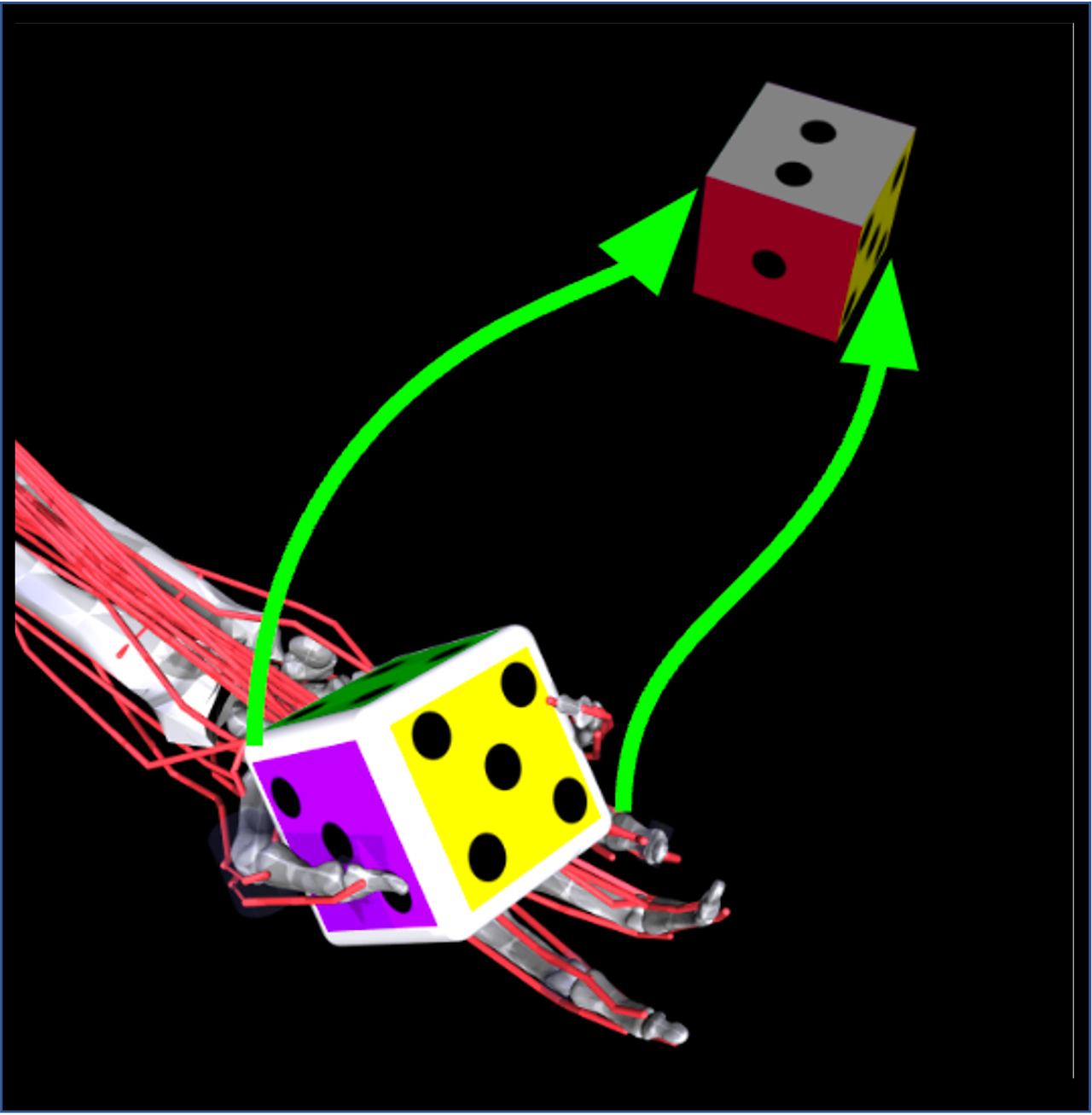
Hand Baoding Balls (MyoChallenge 2022)¶
A myoHand model involved for simultaneous rotation of two free-floating spheres over the palm. This task requires both dexterity and coordination.
- Objective:
Achieve relative rotation of the balls around each other without dropping them.
- Action Space:
The whole set of muscle [0, 1]
- Observation Space:
All joints angles [-\(\pi\), \(\pi\)]
- Variants:
Easy: Swap the position of the balls
myoChallengeBaodingP1-v1Hard: Large range of goal position and rotations. Variability in object size and frictions.
myoChallengeBaodingP2-v1More: Sparse rewards, 3 different dense reward options to choose from
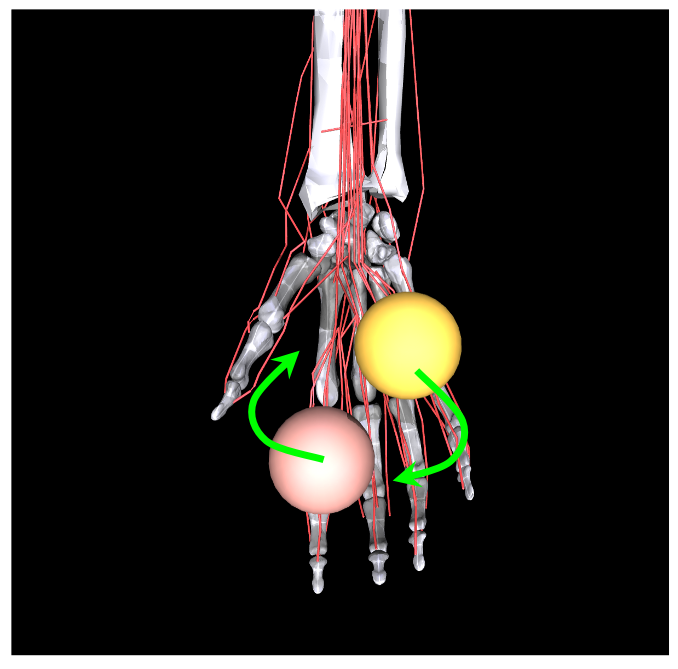
Leg Walk¶
A myoLeg model walks across a flat (or rough) surface. This task requires the control of 80 muscles while stabilizing the body to not fall down.
- Objective:
Achieve target velocities while periodically moving your hip joints.
- Variants:
Easy: Achieve a forward velocity in the y-direction without moving in the x-direction.
myoLegWalk-v0Hard: Achieve a forward velocity in the y-direction without moving in the x-direction on uneven terrain.
myoLeg<Rough|Hilly|Stair>Walk-v0
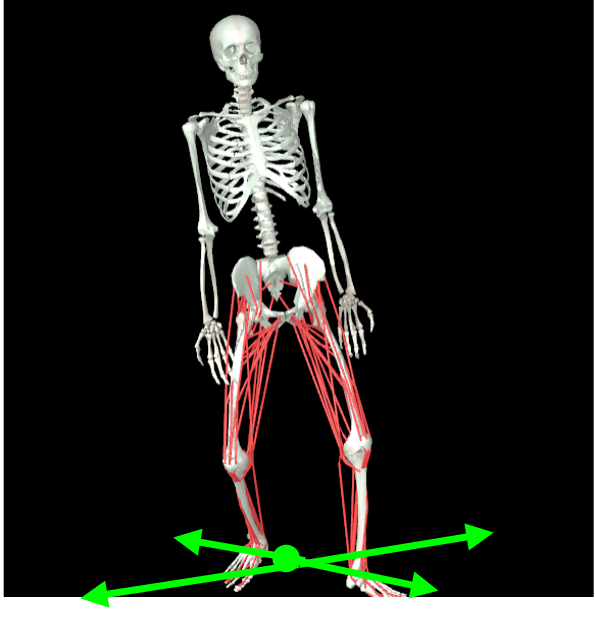
Non-stationarities task variations¶
Sarcopenia¶
Sarcopenia is a muscle disorder that occurs commonly in the elderly population (Cruz-Jentoft and Sayer (2019)) and characterized by a reduction in muscle mass or volume. The peak in grip strength can be reduced up to 50% from age 20 to 40 (Dodds et al. (2016)). We modeled sarcopenia for each muscle as a reduction of 50% of its maximal isometric force.
Fatigue¶
Muscle Fatigue is a short-term (second to minutes) effect that happens after sustained or repetitive voluntary movement and it has been linked to traumas e.g. cumulative trauma disorder (Chaffin et al. (2006)). A dynamic muscle fatigue model (Ma et al. (2009)) was integrated into the modeling framework. This model was based on the idea that different types of muscle fiber that have different contributions and resistance to fatigue (Vøllestad (1997)). The current implementation is simplified to consider the same fatigue factor for all muscles and that muscle can be completely fatigued.

Tendon transfer¶
Contrary to muscle fatigue or sarcopenia that occurs to all muscles, tendon transfer surgery can target a single muscle-tendon unit. Tendon transfer surgery allows redirecting the application point of muscle forces from one joint DoF to another (see below). It can be used to regain functional control of a joint or limb motion after injury. One of the current procedures in the hand is the tendon transfer of Extensor Indicis Proprius (EIP) to replace the Extensor Pollicis Longus (EPL) (Gelb (1995)). Rupture of the EPL can happen after a broken wrist and create a loss of control of the Thumb extension. We introduce a physical tendon transfer where the EIP application point of the tendon was moved from the index to the thumb and the EPL was removed (see Figure 3).
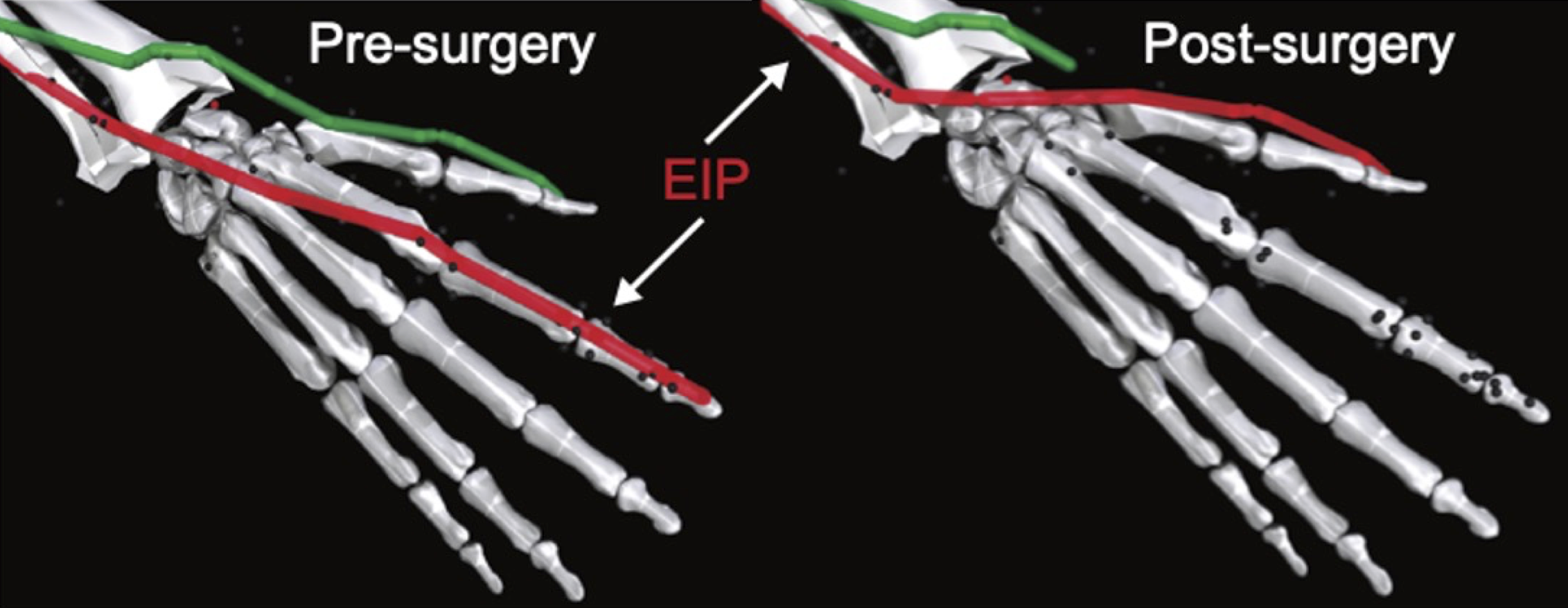
Exoskeleton assistance¶
Exoskeleton assisted rehabilitation is becoming more and more common practice (Jezernik et al. (2003)) due to its multiple benefit (Nam et al. (2017)). Modeling of an exoskeleton for the elbow was done via an ideal actuator and the addition of two supports with a weight of 0.101 Kg for the upper arm and 0.111 Kg on the forearm. The assistance given by the exoskeleton was a percentage of the biological joint torque, this was based on the neuromusculoskeletal controller presented in Durandau et al. (2019).
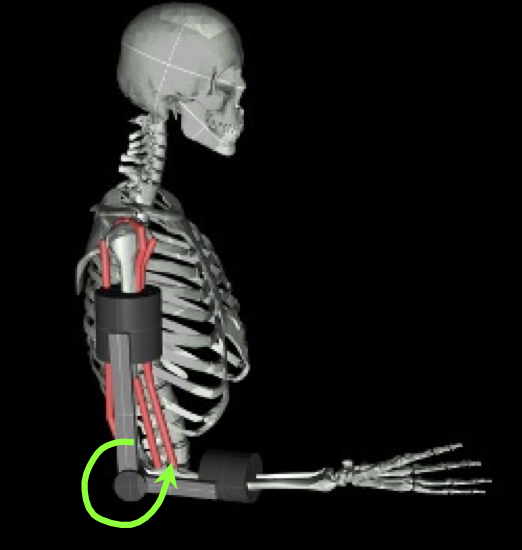
Summary of task and variantions¶
Environment |
Difficulty |
||||
Finger Joint Pose |
|
Easy |
✓ |
✓ |
|
Finger Joint Pose |
|
Hard |
✓ |
✓ |
|
Finger Tip Reach |
|
Easy |
✓ |
✓ |
|
Finger Tip Reach |
|
Hard |
✓ |
✓ |
|
Elbow Joint Pose |
|
Hard |
✓ |
✓ |
|
Hand Joints Pose |
|
Easy |
✓ |
✓ |
✓ |
Hand Joints Pose |
|
Hard |
✓ |
✓ |
✓ |
Hand Tips Reach |
|
Easy |
✓ |
✓ |
✓ |
Hand Tips Reach |
|
Hard |
✓ |
✓ |
✓ |
Hand Key Turn |
|
Easy |
✓ |
✓ |
✓ |
Hand Key Turn |
|
Hard |
✓ |
✓ |
✓ |
Hand Object Hold |
|
Easy |
✓ |
✓ |
✓ |
Hand Object Hold |
|
Hard |
✓ |
✓ |
✓ |
Hand Pen Twirl |
|
Easy |
✓ |
✓ |
✓ |
Hand Pen Twirl |
|
Hard |
✓ |
✓ |
✓ |
Die Rotation |
|
Easy |
✓ |
✓ |
✓ |
Die Rotation |
|
Hard |
✓ |
✓ |
✓ |
Hand Baoding Balls |
|
Easy |
✓ |
✓ |
✓ |
Hand Baoding Balls |
|
Hard |
✓ |
✓ |
✓ |
8 Obj. Rotation |
|
Easy |
✓ |
✓ |
✓ |
100 Obj. Rotation |
|
Easy |
✓ |
✓ |
✓ |
1000 Obj. Rotation |
|
Hard |
✓ |
✓ |
✓ |
1000 Obj. Rotation |
|
Hard |
✓ |
✓ |
✓ |
Leg walk |
|
Easy |
✓ |
✓ |
|
Leg walk Rough Ground |
|
Hard |
✓ |
✓ |
|
Leg walk Hilly Ground |
|
Hard |
✓ |
✓ |
|
Leg walk Stair Ground |
|
Hard |
✓ |
✓ |
|
Grasping & Placing |
|
Easy |
✓ |
✓ |
|
Chase Tag |
|
Easy |
✓ |
✓ |
- Variations:
Sarcopenia: myoSarc<Environment> e.g. myoSarcHandPoseFixed-v0
Fatigue: myoFati<Environment> e.g. myoFatiElbowPose1D6MRandom-v0
TTransfer / Reafferentation: myoReaf<Environment> e.g. myoReafHandPoseFixed-v0